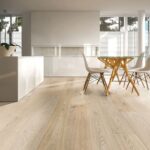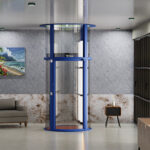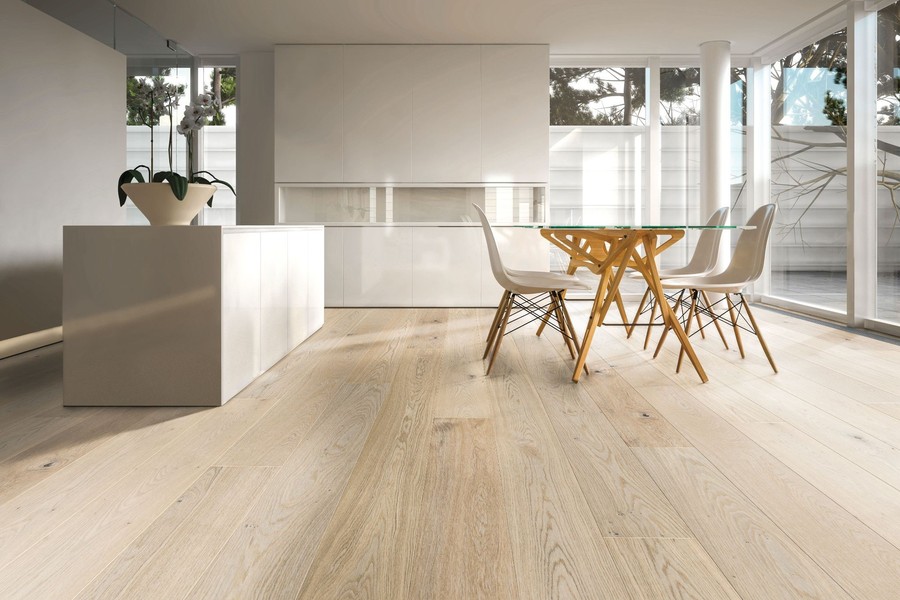When it comes to creating a timeless, natural look underfoot, few materials rival oak, but one of the biggest decisions you’ll make when choosing your flooring is whether to go for solid oak or engineered oak. Both options are beautiful, durable and add warmth to any home, but the right choice depends on where you plan to install it and how you live day to day.
Here’s how to decide which option suits your space best.
What Is Solid Oak Flooring?
Solid oak flooring is made from a single piece of oak, cut and machined into planks. It’s the most traditional and authentic option, full of natural grain, knots and colour variations that give each board unique character.
Because it’s pure timber through and through, it can be sanded and refinished several times, making it a long term investment. Many homeowners love it for its heritage appeal and genuine feel underfoot.
However, being a natural material, solid oak expands and contracts with temperature and humidity changes. That means it’s not ideal for basements, bathrooms, or homes with underfloor heating unless carefully installed and maintained.
What Is Engineered Oak Flooring?
Engineered oak flooring is built differently. It features a real oak top layer bonded to multiple layers of plywood beneath. This layered construction makes it incredibly stable, preventing warping or movement caused by moisture or heat.
The result? A floor that looks and feels just like solid oak but performs better in modern homes. It’s especially popular in open plan spaces, new builds and rooms with underfloor heating. Engineered oak can also be sanded and refinished (depending on the thickness of the top layer), giving it impressive longevity for a more practical price.
Key Differences Between the Two
Here’s how they compare in the areas that matter most:
- Appearance: Both look nearly identical once installed. Engineered oak has a genuine oak surface, while solid oak is solid timber throughout.
- Durability: Solid oak can last for generations with care. Engineered oak is also long lasting but has a finite number of sandings.
- Stability: Engineered oak is far less prone to warping or shrinkage, making it ideal for rooms where humidity varies.
- Installation: Engineered boards can often be “floated” (click fit or glued), while solid oak usually needs to be nailed or fully glued down by a professional.
- Cost: Solid oak tends to be more expensive due to its all wood construction, while engineered oak offers a more budget friendly route to the same look.
Which One Should You Choose?
If you love traditional craftsmanship and want flooring that can be passed down through generations, solid oak flooring offers unmatched authenticity and timeless appeal.
But if you’re after something easier to install, more stable and compatible with underfloor heating, engineered oak flooring is the smarter, more versatile choice.
Both provide the unmistakable warmth and character that make oak such a design favourite.
Frequently Asked Questions
Can engineered oak flooring be sanded?
Yes, most engineered floors can be sanded one or two times depending on the veneer thickness. It’s a great way to refresh them after years of use.
Is solid oak flooring suitable for underfloor heating?
Not typically. The natural expansion and contraction of solid wood make it unsuitable for consistent heat exposure. Engineered oak is the better fit.
Which type lasts longer?
Solid oak can last a lifetime with proper maintenance. Engineered oak also offers excellent durability, especially in modern living conditions.
How do I care for oak flooring?
Sweep or vacuum regularly, avoid excessive moisture and clean with a pH-neutral wood cleaner. Applying protective pads under furniture also helps prevent scratches.
Final Thoughts
Whether you choose solid or engineered oak flooring, both options bring warmth, texture and natural beauty that few other materials can match. Solid oak offers timeless character and longevity, while engineered oak provides modern practicality and stability.
The best choice often comes down to your space and lifestyle, traditional homes may suit the depth of solid timber, while newer builds benefit from engineered versatility. Either way, investing in real oak flooring ensures your home feels grounded, elegant and built to last.










